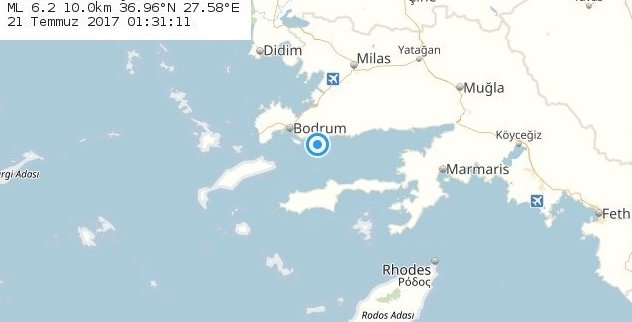An earthquake of magnitude 6.3 hit western Muğla province early Friday. No casualties have been reported in Turkey, while at least two people were killed and scores injured on the nearby Greek island of Kos.
Police said a Swede and a Turk died in an area abuzz with nightlife but did not reveal their identities.
Locals have been warned not to stay indoors and tremors have also been felt in İzmir, also in neighboring cities Aydın, Denizli and Antalya.
Dozens of aftershocks were reported.

The moment when the quake struck the coast was also caught on camera.The quake, which struck at 1:31 a.m. (2231 GMT on Thursday), was located off the southwestern coastal city of Marmaris. The U.S. Geological Survey (USGS) said that the quake was as big as magnitude 6.7, while Boğaziçi University's Kandilli Observatory maintains 6.3. It was close to the Turkish town of Bodrum and the Greek island of Kos in the Dodecanese Islands archipelago.
The temblor, initially reported as a magnitude 6.9, was very shallow, only 6.2 miles (10 km) below the seabed, the USGS said.
The Greek island of Kos, which was nearest to the epicenter, appeared to be the worst-hit with deaths and over 120 injuries reported.
The harbor area in Kos was flooded, according to witnesses, damaging several boats, while social media users on the island posted pictures of badly damaged buildings and flooding.
The minarets on two old mosques and part of a church also collapsed. As day dawned, the clean-up operation began, with a plane and two helicopters arriving with rescue workers from Athens.
Kos's "old town" area, full of bars and other nighttime entertainment, was littered with broken stone in the streets. Hotels had shattered glass and other damage, leaving hundreds of tourists to spend the rest of the night outdoors, trying to sleep on beach loungers with blankets provided by staff.
Kos and Bodrum are about 10 kilometers apart across the Aegean Sea.
A magnitude 6.7 quake is considered strong and is capable of causing considerable damage, but the effects of this one would have been dampened by seas.
Turkey is among one of the world's most seismically active countries as it is situated on a number of active fault lines, with the most potentially devastating one being the Northern Anatolia Fault (NAF), where the Anatolian and Eurasian plates meet.
The NAF, a strike-slip fault formed as the Anatolian plate was being pushed northwestwards by the Arabian plate, has produced devastating earthquakes throughout history, with the most recent ones being magnitude 7.4 and 7.2 earthquakes in northwestern Izmit and Düzce provinces in August and December 1999. The 1999 earthquakes killed thousands in Kocaeli, Adapazarı, Istanbul, Yalova and nearby towns in the northwest, which serve as Turkey's economic and industrial heartland.
In the latest earthquake-related disaster, than 600 people died in October 2011 in the eastern province of Van after a quake of 7.2 magnitude and powerful aftershocks.
Years after the disaster, Turkey has seen an overhaul in measures to prevent damage from earthquakes, such as compulsory earthquake insurance and campaigns to raise awareness and inform the public about earthquake preparedness.
Additionally, the government has undertaken the ambitious project of urban transformation wherein old and crumbling buildings across the country are being demolished to make way for new, earthquake resistant buildings.
Scientists have warned that the epicenter of Turkey's next big earthquake is likely to occur under the Sea of Marmara, where the NAF passes.